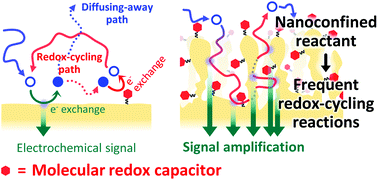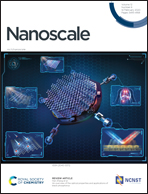Tethered molecular redox capacitors for nanoconfinement-assisted electrochemical signal amplification†
Abstract
Nanostructured materials offer the potential to drive future developments and applications of electrochemical devices, but are underutilized because their nanoscale cavities can impose mass transfer limitations that constrain electrochemical signal generation. Here, we report a new signal-generating mechanism that employs a molecular redox capacitor to enable nanostructured electrodes to amplify electrochemical signals even without an enhanced reactant mass transfer. The surface-tethered molecular redox capacitor engages diffusible reactants and products in redox-cycling reactions with the electrode. Such redox-cycling reactions are facilitated by the nanostructure that increases the probabilities of both reactant–electrode and product–redox-capacitor encounters (i.e., the nanoconfinement effect), resulting in substantial signal amplification. Using redox-capacitor-tethered Au nanopillar electrodes, we demonstrate improved sensitivity for measuring pyocyanin (bacterial metabolite). This study paves a new way of using nanostructured materials in electrochemical applications by engineering the reaction pathway within the nanoscale cavities of the materials.



 Please wait while we load your content...
Please wait while we load your content...